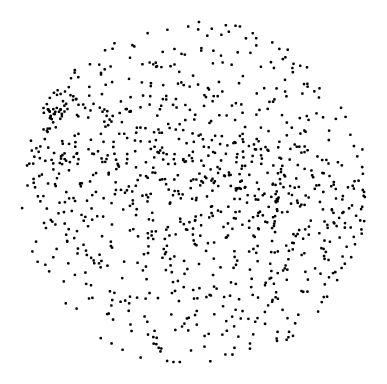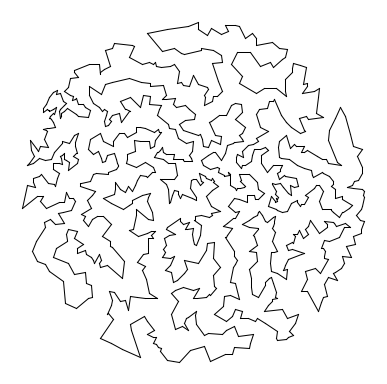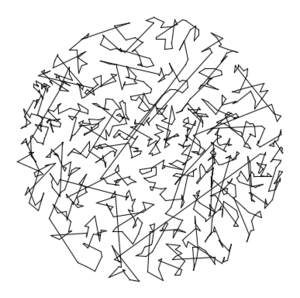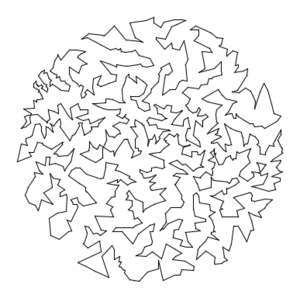 |
 |
||
| 1,000 points | optimal tour |
| COS 126 Traveling Salesperson Problem |
Programming Assignment |
Given N points in the plane, the goal of a traveling salesperson is to visit all of them (and arrive back home) while keeping the total distance traveled as short as possible. Implement two greedy heuristics to find good (but not optimal) solutions to the traveling salesperson problem (TSP).
1,000 points optimal tour
Perspective. The importance of the TSP does not arise from an overwhelming demand of salespeople to minimize their travel distance, but rather from a wealth of other applications such as vehicle routing, circuit board drilling, VLSI design, robot control, X-ray crystallography, machine scheduling, and computational biology.
Greedy heuristics. The traveling salesperson problem is a notoriously difficult combinatorial optimization problem, In principle, one can enumerate all possible tours and pick the shortest one; in practice, the number of tours is so staggeringly large (roughly N factorial) that this approach is useless. For large N, no one knows an efficient method that can find the shortest possible tour for any given set of points. However, many methods have been studied that seem to work well in practice, even though they are not guaranteed to produce the best possible tour. Such methods are called heuristics. Your main task is to implement the nearest neighbor and smallest increase insertion heuristics for building a tour incrementally. Start with a one-point tour (from the first point back to itself), and iterate the following process until there are no points left.
Point data type. A Point represents a point in the plane, as described by the following API:
public class Point (2D point data type)
---------------------------------------------------------------------------------------
Point(double x, double y) // create the point (x, y)
String toString() // return string representation
void draw() // draw point using standard draw
void drawTo(Point that) // draw line segment between the two points
double distanceTo(Point that) // return Euclidean distance between the two points
Tour data type. Your task is to create a Tour data type that represents the sequence of points visited in a TSP tour. Represent the tour as a circular linked list of nodes, one for each point. Each Node will contain a Point and a reference to the next Node in the tour. Within Tour.java, define a nested class Node in the standard way:
private class Node {
private Point p;
private Node next;
}
public class Tour // As usual, the constructors and methods in the API must be public
----------------------------------------------------------------------------------------------
Tour() // create an empty tour
Tour(Point a, Point b, Point c, Point d) // create a 4 point tour a->b->c->d->a
void show() // print the tour to standard output
void draw() // draw the tour to standard draw
int size() // number of points on tour
double distance() // return the total distance of the tour
void insertNearest(Point p) // insert p using nearest neighbor heuristic
void insertSmallest(Point p) // insert p using smallest increase heuristic
Input and testing. The input format will begin with two integers w and h, followed by pairs of x- and y-coordinates. All x-coordinates will be real numbers between 0 and w; all y-coordinates will be real numbers between 0 and h. Many test data files are available. As an example, tsp1000.txt contains the following data:
After implementing Tour.java, use the client program NearestInsertion.java to read in the points from standard input, run the nearest neighbor heuristic; print the resulting tour, its distance, and its number of points to standard output; and draw the resulting tour to standard draw. SmallestInsertion.java is analogous but runs the smallest insertion heuristic.% more tsp1000.txt 775 768 185.0411 457.8824 247.5023 299.4322 701.3532 369.7156 563.2718 442.3282 144.5569 576.4812 535.9311 478.4692 383.8523 458.4757 329.9402 740.9576 ... 254.9820 302.2548
% java-introcs NearestInsertion < tsp1000.txt (185.0411, 457.8824) (198.3921, 464.6812) (195.8296, 456.6559) (216.8989, 455.126) (213.3513, 468.0186) (241.4387, 467.413) (259.0682, 473.7961) (221.5852, 442.8863) ... (264.57, 410.328) Tour distance = 27868.7106 Number of points = 1000 |
% java-introcs SmallestInsertion < tsp1000.txt (185.0411, 457.8824) (195.8296, 456.6559) (193.0671, 450.2405) (200.7237, 426.3461) (200.5698, 422.6481) (217.4682, 434.3839) (223.1549, 439.8027) (221.5852, 442.8863) ... (186.8032, 449.9557) Tour distance = 17265.6282 Number of points = 1000 |
||
 |
 |
Files provided. This week we provide many test cases, expected outputs for some of those test cases, the utility class Point, the three clients NearestInsertion, SmallestInsertion, and TSPTimer, and the readme.txt templates. You can obtain them all in this .zip file. Alternatively, you can obtain them through the course FTP site. Be sure to test your Tour.java thoroughly using both the short test diagnostic files and the longer ones.
Analysis. In your readme.txt, estimate the running time of your program as a function of the number of points N. Use TSPTimer.java to help collect your data points (it relies on Stopwatch which should already be installed for most people). Run the two heuristics for N = 10000, and repeatedly double N until the execution time exceeds 60 seconds. (If running on N = 10000 already takes more than a minute, your code is too slow — see the checklist.)
Submission. Submit Tour.java and readme.txt (or just the abbreviated partner readme.txt if your partner submitted the code).
If you and your partner both do the extra credit separately, you are both allowed to upload .java files to facilitate testing.
Contest and extra credit.
This part may be done individually or with your partner.
Implement a better heuristic. For example,
observe that any tour with paths that cross can be transformed
into a shorter one with no crossing paths: add that improvement to
your program.
Here are some other ideas.
Name your extra credit program ExtraCredit.java;
the only public method in its API should be main,
which should read an input file
in the same format as the sample test files. Then it should output
in the same format as the sample SmallestInsertion client
(using Point.toString()).
The running time should be at most 60 seconds when N=1000.
Submit it
along with any accompanying files and describe it in the readme.txt.
We will award a special prize to whoever finds the shortest
tour around tsp1000.txt.
Some people may want to use Tour.java as a starting point for their extra credit submissions, but they will need to add extra public methods in order to do something new. To allow this without requiring that large chunks of code are copied, we will ignore any "API violations" for extra public methods in Tour that are used only for the purposes of completing the extra credit portion of the assignment. Alternatively, you can inherit ExtraCredit from Tour if you change a few private items in Tour.java to be protected. Again, we will ignore these specific API violations.
This assignment was developed by Bob Sedgewick and Kevin Wayne.